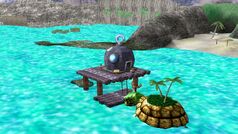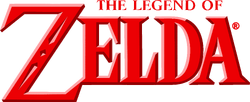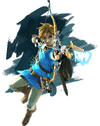Super Smash Bros. Melee is a crossover fighting game released for the Nintendo GameCube in 2001. It is a sequel to the 1999 Nintendo 64 game Super Smash Bros. and therefore the second installment of the series. It features many The Legend of Zelda characters, stages, and items, alongside those of other popular Nintendo series including Mario and Pokémon.
Characters from The Legend of Zelda
Super Smash Bros. Melee features Link, Zelda/Sheik, Ganondorf, and Young Link as playable characters. They are each based on their appearance in Ocarina of Time.
Link

Link's moveset includes many attacks and items from The Legend of Zelda series, including the Master Sword for most of his smash attacks, the Spin Attack as his recovery, the Jump Thrust and Down Thrust, the Hookshot as his grab, and the Bow, Boomerang and Bombs as projectiles. Link can also crouch to use the Hylian Shield to protect himself from projectiles.
Link's costumes include the Kokiri Tunic as his main costume, the Goron Tunic and Zora Tunic, and a lavender tunic based on the Blue Ring palette swap from the original The Legend of Zelda as his alternative costumes.
Young Link

Young Link is faster and lighter but weaker than his clone, adult Link. He uses Fire Arrows instead of normal ones. Young Link uses the Kokiri Sword and Deku Shield. His taunt features him drinking Lon Lon Milk.
Zelda/Sheik


Zelda's moveset includes the three spells featured in Ocarina of Time. Farore's Wind is used as her recovery, Din's Fire is a ranged attack, and Nayru's Love is used to reflect projectiles.
Zelda can transform into Sheik and vice versa at any time during a battle. Sheik's recovery resembles his vanishing move from Ocarina of Time.
Ganondorf

Ganondorf is a heavier, stronger clone of Captain Falcon. He possesses the same moveset but with different names, such as the Gerudo Dragon. In some cutscenes and artwork, Ganondorf can be seen holding a sword. However, it is not part of his moveset.
Stages from The Legend of Zelda
Termina: Great Bay

Taken from Majora's Mask, the Great Bay stage features the Marine Research Lab as the main platform. A rock platform stands to the left and the Turtle to the right; the palm trees on his back serve as two smaller platforms. After a while, the Turtle will hide underwater, reappearing after a set amount of time. Unlike in the original source material, the water cannot be swam in, and it is also a much cleaner, brighter color.
Tingle makes a cameo appearance floating on a balloon that can be used as a platform. If a player stands long enough on the balloon, or it is pierced by an attack, it will burst and drop Tingle on the platform below. Eventually, Tingle will blow up another balloon, like in the N64 game.
The Four Giants and the Moon also make a cameo appearance in the background. As the fight progresses, the Moon will come closer to the ground. Eventually, the Four Giants will appear and stop the Moon, returning it to its original position.

Hyrule: Temple
The Temple stage is based on the Palaces from The Adventure of Link. Its soundtrack is a rearrangement of the Palace theme in the NES game. The stage appears in two events: Lv. 18: Link's Adventure and Lv. 29: Triforce Gathering.
Underground Maze
The Adventure Mode features a The Legend of Zelda-themed stage, the Underground Maze. In it, the player must search for the Triforce around a maze in order to finish the level. ReDeads, Like Likes, and Octoroks appear as enemies throughout the maze. If the player finds a Master Sword instead of the Triforce, a fight with Link will be triggered. Similarly to Temple, the default BGM theme is a rearrangement of the palace theme from The Adventure of Link.
Items from The Legend of Zelda
Heart Containers reappear from the original game as recovery items. However, rather than recovering all damage, they only decrease 100% of damage. In addition, Bunny Hoods improve players' agility, allowing them to jump higher and move faster.
30 different The Legend of Zelda-related trophies appear in the game. These include the playable characters in different poses, non-playable characters, items and enemies.
Trivia
- This title is the Nintendo GameCube's best-selling game, with over 7.4 million sold.
- The Links featured in this game is the iconic Hero of Time in both his child and adult age, with the latter returning from the previous game. The former would not return in the Super Smash Bros. series until Ultimate.
- Dark Link is featured in this game as a separate character rather than an alternate costume for Link, in the Event Match 18 ("Link's Adventure") battle.
- Super Smash Bros. Melee is a popular installment among older fans of the series, due to its improvement over the original game and gameplay features/graphics that aged well today. Because of this, some fans have forgotten about its age or believe this title is the first game, which consequently overshadowed Super Smash Bros. and even the later games.

- Ganondorf's unused sword seen in this game in one of his victory poses is actually taken from the now-infamous SpaceWorld 2000 GameCube Tech Demo (where his and Link's model designs were based on).
Nomenclature
| Language | Name | |
|---|---|---|
| Japanese | 大乱闘 スマッシュ ブラザーズDX (Dairantō Sumasshu Burazāzu Dī Ekkusu) | |
Gallery

|
View Gallery |
External links
- Super Smash Bros. Melee on Smashpedia
- Super Smash Bros. Melee on the Mario Wiki


